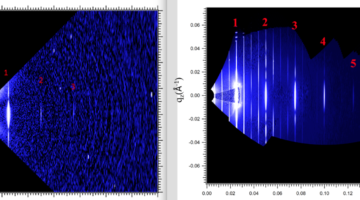A new measurement technique developed at the ALS is helping guide the semiconductor industry in next-generation nanopatterning techniques. NIST and IBM researchers collaborated on the technique, which allows scientists to evaluate the 3D buried features inside a film. The ALS is currently the only place in the world that has such capability.
Advances in Lithography
Work featured on Applied Optics cover from ALS Beamline 11.3.2. Field-dependent wavefront aberration distribution of an extreme ultraviolet single-lens zone-plate microscope, recovered by the gradient descent algorithm customized for partially coherent imaging and targeted for fast and accurate retrieval. Read more »
An Evolutionary Arms Race for Sulfur
Recent work at the ALS shows that the viruses infecting sulfur-oxidizing bacteria in the deep sea carry bacterial genes for the oxidation of elemental sulfur. Although the viruses themselves cannot use the sulfur, they likely supplement bacterial sulfur oxidation and then exploit the generated energy for viral replication. Read more »
From CO2 to Methanol via Novel Nanocatalysts
Researchers have found novel nanocatalysts that lower the barrier to converting carbon dioxide—an abundant greenhouse gas—into methanol—a key commodity used to produce numerous industrial chemicals and fuels. In one case, it worked almost 90 times faster than catalysts commonly used for this reaction today. Read more »![]()
![]()
Designer Proteins Target Epstein-Barr-Virus-Associated Cancer
Researchers used new protein design approaches to develop a potential inhibitor of Epstein-Barr-Virus-associated cancer. The study shows not just how to help defeat the virus, but also opens up a whole new way to design proteins against viruses and ultimately, cancer. Read more »![]()
![]()
Scott Taylor, ALS Safety Manager
The new Safety Manager at the ALS, Scott Taylor, is not so new. Taylor has been working at Berkeley Lab for 30 years now, starting in his early days as a biofuels researcher working with Melvin Calvin. Taylor isn’t new to safety either—he has been on the Lab’s Safety Review Committee since 1992 and the division safety coordinator for Life Sciences for the past six years. Read more »
The Electronic Structure of a Two-Dimensional Pure Copper Oxide Lattice
All superconducting cuprates share a common structure: charge reservoirs stacked between layers of CuO2. An undoped version, including only C and O, is not available in nature. By growing epitaxial films with a pulsed-laser deposition facility, researchers stabilized a 2D version of CuO, which can be thought as composed by two CuO2 planes staggered and superposed.
ALS Evidence Confirms Combustion Theory
Researchers recently uncovered the first step in the process that transforms gas-phase molecules into solid particles like soot and other carbon-based compounds. It’s a discovery that could help combustion chemists make more efficient, less polluting fuels and help materials scientists fine-tune their carbon nanotubes and graphene sheets for faster, smaller electronics. Read more »![]()
![]()
An Iridate with Fermi Arcs
Researchers have discovered that “Fermi arcs,” much-debated features found in the electronic structure of high-temperature superconducting (HTSC) cuprates, can also be found in an iridate (iridium oxide) compound—strontium iridate. Read more »![]()
![]()
ALS Workshop Highlights Diffraction-Limited Storage Ring Opportunities
On October 1-3, 2014, the ALS hosted a workshop on Soft X-Ray Science Opportunities Using Diffraction-Limited Storage Rings. The workshop charge was to elaborate transformational research opportunities that would be enabled by emerging storage-ring-based ultrahigh brightness. Read more »
- « Previous Page
- 1
- …
- 3
- 4
- 5
- 6
- 7
- …
- 17
- Next Page »






